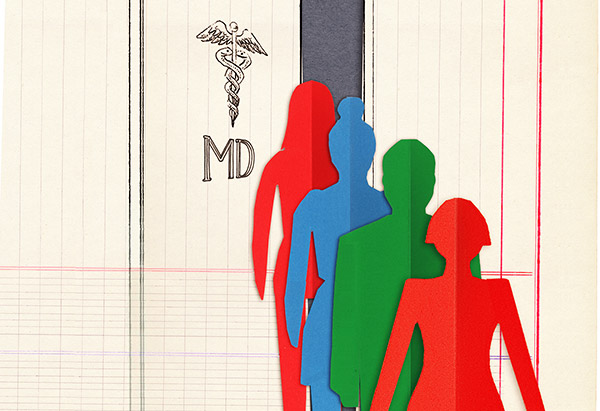Can You Get More from Your Checkup If You Share It with Strangers?
We investigate a growing medical trend: shared appointments.

Illustration: Maria Bruni
At 8 a.m. on a crisp fall morning, Allison*, a woman in her late 40s, is bending at the waist in an attempt to touch her toes. Allison suffers from back problems and numbness in her leg, and the doctor wants to see how low she can go before the pain hits; she gets to about midshin and stops. Most days, she says, her discomfort registers an eight out of ten.
Allison has a roomful of observers who feel her pain—almost literally. Around her, in a loose semicircle, are three other patients with back problems awaiting their own turns with the doctor, Terence Doorly, MD. They're all first-time patients of his and have signed up to see him in a group session. They watch as Doorly, an energetic neurosurgeon, tests Allison's reflexes, then pulls up her latest MRI scans and points to the large herniated disk near the base of her spine. They learn, along with Allison, that this is the root of her pain, and that she'll likely need surgery.
As Allison slides off the exam table (fully clothed, in case you're wondering), patient number two steps up. Jack*, who is in his early 70s, was blindsided by sudden pain in his back two weeks ago ("like someone had jabbed a knitting needle into my spine"). Doorly asks Jack about his symptoms, checks his range of motion, and reviews his scans. Prognosis: Jack won't need surgery but will require plenty of physical therapy. "You made out better than poor Allison!" Doorly jokes in his Irish brogue, and even Allison laughs good-naturedly at her worst-case-scenario status. No one seems hesitant about sharing personal information. (Jack remarks that steroid injections have made him gain weight he can't seem to lose; Allison says she's been there, too.) The session goes on for another 40 minutes as patients three and four are examined. Then Doorly wraps up by answering questions about treatment options.
Four years ago, Doorly was the first physician at Mass General/North Shore Center for Outpatient Care in Danvers, Massachusetts, to offer shared medical appointments (SMAs). "At first, I did worry that my bond with patients would suffer," he says. "But not a single person has complained that they didn't get enough time with me. So many people have said, 'I wish I'd been doing this all along.' "
While the concept might sound off-putting—one doctor meeting with up to 16 patients of varying ages at the same time—SMAs are catching on. According to the American Academy of Family Physicians (AAFP), the percentage of its members offering SMAs more than doubled, to nearly 12 percent, between 2005 and 2012. And at the Cleveland Clinic, where nearly 10,000 group appointments have been logged since 2002 (8,600 of them took place within the last three years), satisfaction is high: 85 percent of people who attend one SMA sign up for another.
Next: The surprising perks of the "more-the-merrier" approach
Allison has a roomful of observers who feel her pain—almost literally. Around her, in a loose semicircle, are three other patients with back problems awaiting their own turns with the doctor, Terence Doorly, MD. They're all first-time patients of his and have signed up to see him in a group session. They watch as Doorly, an energetic neurosurgeon, tests Allison's reflexes, then pulls up her latest MRI scans and points to the large herniated disk near the base of her spine. They learn, along with Allison, that this is the root of her pain, and that she'll likely need surgery.
As Allison slides off the exam table (fully clothed, in case you're wondering), patient number two steps up. Jack*, who is in his early 70s, was blindsided by sudden pain in his back two weeks ago ("like someone had jabbed a knitting needle into my spine"). Doorly asks Jack about his symptoms, checks his range of motion, and reviews his scans. Prognosis: Jack won't need surgery but will require plenty of physical therapy. "You made out better than poor Allison!" Doorly jokes in his Irish brogue, and even Allison laughs good-naturedly at her worst-case-scenario status. No one seems hesitant about sharing personal information. (Jack remarks that steroid injections have made him gain weight he can't seem to lose; Allison says she's been there, too.) The session goes on for another 40 minutes as patients three and four are examined. Then Doorly wraps up by answering questions about treatment options.
Four years ago, Doorly was the first physician at Mass General/North Shore Center for Outpatient Care in Danvers, Massachusetts, to offer shared medical appointments (SMAs). "At first, I did worry that my bond with patients would suffer," he says. "But not a single person has complained that they didn't get enough time with me. So many people have said, 'I wish I'd been doing this all along.' "
While the concept might sound off-putting—one doctor meeting with up to 16 patients of varying ages at the same time—SMAs are catching on. According to the American Academy of Family Physicians (AAFP), the percentage of its members offering SMAs more than doubled, to nearly 12 percent, between 2005 and 2012. And at the Cleveland Clinic, where nearly 10,000 group appointments have been logged since 2002 (8,600 of them took place within the last three years), satisfaction is high: 85 percent of people who attend one SMA sign up for another.
Next: The surprising perks of the "more-the-merrier" approach



